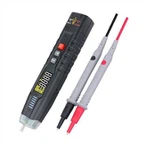Working principle and precautions of clamp meter
The clamp meter is an instrument that integrates a current transformer and an ammeter, and its working principle is the same as that of a current transformer for measuring current. A clamp meter is a combination of a current transformer and an ammeter. The iron core of the current transformer can be opened when the wrench is tightened; the wire through which the measured current passes can pass through the gap opened by the iron core without being cut off, and the iron core is closed when the wrench is released. The measured circuit wire passing through the iron core becomes the primary coil of the current transformer, and the current is induced in the secondary coil by passing the current. So that the ammeter connected to the secondary coil has an indication ----- measure the current of the line under test.
The clamp meter can be changed to different ranges by changing the gear of the switch. But it is not allowed to operate with electricity when shifting gears. The clamp meter is generally not high in accuracy, usually in the range of 2.5 to 5. For the convenience of use, there are switches of different ranges in the meter for the function of measuring different levels of current and measuring voltage.
The clamp meter was originally used to measure AC current, but now it also has the functions of the multimeter, which can measure AC and DC voltage, current, capacitance, diode, triode, resistance, temperature, frequency, etc.
How to use the clamp meter
(1) Mechanical zero adjustment is required before measurement
(2) Select the appropriate range, first select the large range, then select the small range or see the nameplate value for estimation.
(3) When the minimum range is used to measure and the reading is not significant, the measured wire can be wound for several turns, and the number of turns should be based on the number of turns in the center of the jaw, then the reading = indicated value × range / full deviation × turns number
(4) After the measurement is completed, the changeover switch should be placed at the maximum range.
(5) When measuring, the wire under test should be in the center of the jaws, and the jaws should be closed tightly to reduce errors.
Precautions for clamp meter
(1) The voltage of the line under test should be lower than the rated voltage of the clamp meter.
(2) When measuring the current of a high-voltage line, wear insulating gloves, wear insulating shoes, and stand on an insulating mat.
(3) The jaws should be closed tightly and the range cannot be changed while the power is on.
How to use the electrician to measure the clamp meter and matters needing attention
There are two types of clamp ammeters: high and low voltage, which are used to directly measure the current in the line without disconnecting the line. Its usage is as follows:
(1) When using a high-voltage clamp meter, attention should be paid to the voltage level of the clamp ammeter, and it is strictly forbidden to use a low-voltage clamp meter to measure the current of the high-voltage circuit. When measuring with a high-voltage clamp meter, it should be operated by two people. Non-duty personnel should also fill in the second type of work ticket when measuring. They should wear insulating gloves when measuring, stand on insulating mats, and do not touch other equipment to prevent short circuit or grounding.
(2) When observing the timing of the watch, special attention should be paid to maintaining a safe distance between the head and the live parts. The distance between any part of the human body and the live body should not be less than the entire length of the clamp meter.
(3) When measuring on a high-voltage circuit, it is forbidden to use wires to connect the clamp ammeter to another meter for measurement. When measuring the current of each phase of the high-voltage cable, the distance between the cable ends should be more than 300mm, and the insulation should be good. The measurement can only be carried out when the measurement is convenient.
(4) When measuring the current of low-voltage fusible fuses or horizontally arranged low-voltage busbars, the fusible fuses or busbars of each phase should be protected and isolated with insulating materials before measurement to avoid short-circuit between phases.
(5) It is strictly forbidden to measure when one phase of the cable is grounded. Prevent personal safety from being endangered due to ground breakdown explosion due to low insulation level of the cable head.
(6) Pull the switch to the maximum range after the measurement of the clamp ammeter to avoid accidental overcurrent during the next use; and keep it in a dry room






